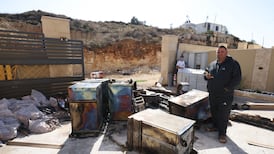A major offensive by Syrian insurgents to break the government siege of opposition-held quarters of Aleppo appeared to have stalled last night, as the battle for control of the city entered a key phase.
The Britain-based monitor Syrian Observatory for Human Rights said the offensive was the largest against government forces since Aleppo, once Syria’s commercial hub, became a focus of the five-year-old war several months ago.
The rebels are trying to break through a strip of government-controlled territory in the hope of reconnecting their area of control in the west of Syria with an encircled sector of eastern Aleppo.
The assault coincided with the opening by Russia of eight humanitarian corridors to evacuate civilians and fighters seeking to leave eastern Aleppo. The UN has so far declined to participate in the evacuation effort.
Up to 300,000 civilians remain in eastern Aleppo neighbourhoods, blockaded since early July when the Syrian army supported by Russian air power and Lebanon’s Hizbullah fighters cut off the last supply route, which runs north to the Turkish border.
Delivering supplies
Russia suffered its greatest single loss of life since entering the war yesterday when a military helicopter was shot down about 25 miles south of Aleppo in
Idlib
province, killing three crew and two officers.
The aircraft had been delivering supplies to the Aleppo area, according to the Russian defence ministry.
It was the third Russian helicopter lost this year, giving rise to speculation in Moscow that insurgents have acquired shoulder-fired surface-to-air missiles, known as Stingers or “Manpads”.
Such a development could have strategic ramifications for Russia and its allies.
There was no immediate claim of responsibility for the attack.
Saudi Arabia and Qatar, which possess stocks of Manpads, had been urging the US to authorise their provision to insurgent factions fighting the government in Syria. Washington refused, fearing the weapons could fall into the hands of Islamic State .
However, a covert "Plan B" for Syria advocated by US military experts involved the supply of Manpads to "moderate" rebels to counter Russia's efforts to support Damascus. It is unclear if that plan has been activated.
After early gains, yesterday’s assault on government positions, mounted partly by radical fundamentalist group Jabhat Fatah al-Sham – known as Jabhat al-Nusra until last week – was countered by government forces at an artillery base and a school.
The spike in the fighting around Aleppo has raised fears that the humanitarian situation could deteriorate further.
UN envoy Staffan di Mistura said last Friday that the city’s food supplies would last three weeks.
UN agencies have stockpiled foodstuffs and medicines to provide for 145,000 people for a month, but fresh fruit, meat and vegetables, fuel and cooking gas are in short supply.
Although under international pressure to lift the siege, Damascus seeks to make gains in and around Aleppo ahead of UN-brokered talks scheduled for the end of this month.
















